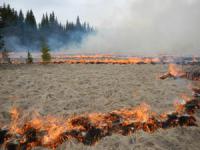-
As floods increase, cities like Detroit are looking to green stormwater infrastructure
Urban sprawl meant paving over grasslands and wetlands, making it so water is unable to soak into the ground. Today, that impervious development, coupled with the more intense storms brought by climate change, is making flooding a major issue for many cities. Urban areas are looking for better ways to manage runoff.
-
-
Better earthquake protection for buildings
Researchers examine how buildings with externally bonded fiber-reinforced polymer composite retrofits withstood the 30 November 2018 magnitude 7.1 earthquake in Alaska. By assessing how these buildings held up, the researchers hope to help engineers construct buildings that stand up to natural disasters.
-
-
As planet warms, even little precipitation may disrupt road networks
A new computer model shows that as more rain falls on a warming planet, it may not take a downpour to cause widespread disruption of road networks. The model combined data on road networks with the hills and valleys of topography to reveal “tipping points” at which even small localized increases in rain cause widespread road outages.
-
-
Extreme floods associated with distinct atmospheric patterns
Extreme floods across the continental United States are associated with four broad atmospheric patterns, a machine-learning based analysis of extreme floods found.
-
-
Revisions to National Seismic Hazard model proposed
As many as 34 million people in the U.S.(about one in nine people) are expected to experience a strong level of shaking at least once in their lifetimes. Experts say that the U.S. National Seismic Hazard Model (NSHM) should be revised to reflect the greater likelihood of ground shaking across many locations in the central and eastern United States.
-
-
Maths shows the nature of “tipping points” for climate, eco crises
Humans need to be wary of breaching a “point of no return” that leads to ecological disaster such as loss of rainforests or irreversible climate change, according to the most detailed study of its kind.
-
-
A Seattle quake may cause more damage than expected to reinforced concrete
Using ground motions generated for a range of simulated magnitude 9 earthquakes in the Pacific Northwest, researchers are testing how well reinforced concrete walls might stand up under such seismic events. The walls may not fare so well, especially within the city of Seattle, the researchers say.
-
-
Forest fires accelerating snowmelt across western U.S., affecting water supplies
Forest fires are causing snow to melt earlier in the season, a trend occurring across the western U.S. that may affect water supplies and trigger even more fires, according to a new study. It is a cycle that will only be exacerbated as the frequency, duration, and severity of forest fires increase with a warmer and drier climate.
-
-
The why, how, where, and what of earthquake early warning
Earlier this year, Los Angeles became one of the first cities in the country to roll out ShakeAlert – a dedicated earthquake early warning system. Advanced warning of an earthquake has long been a goal for everyone from seismologists to local governments. Especially in cities like Los Angeles, located along the notorious San Andreas fault. But what about cities like Seattle?
-
-
Fracking Linked to earthquakes in the Central and Eastern United States
Small earthquakes in Ohio, Pennsylvania, West Virginia, Oklahoma and Texas can be linked to hydraulic fracturing wells in those regions, according to researchers. While relatively rare compared to earthquakes caused by wastewater disposal in oil and gas fields in the central United States, the researchers have identified more than 600 small earthquakes (between magnitude 2.0 and 3.8) in these states.
-
-
“Metamaterials” may mitigate earthquake damage

In the past decade scientists have been experimenting with metamaterials, artificial materials designed with periodic internal structures to give them properties not found in natural materials. Some of these materials can control waves propagating through them, filtering sound or deflecting light so that an object appears “cloaked” or invisible, for instance. Could this same principle be applied to controlling seismic waves?
-
-
Mozambique hit by another unprecedented tropical cyclone
A few weeks after Cyclone Idai which wreaked havoc on central Mozambique (and eastern Zimbabwe), the country is dealing with another unprecedented event. Tropical Cyclone Kenneth made landfall in northern Mozambique on 25 April, near the border with Tanzania, in an area where no tropical cyclone has been observed since the satellite era. There is no record of two storms of such intensity striking Mozambique in the same season. It has now weakened into a depression.
-
-
California: Coastal impacts of climate change
The United States Geological Survey (USGS) says that sea-level rise is going to wreak widespread destruction on California’s coastal communities, unless these communities take urgent action to mitigate to risks. “Even the storms today have significant risk to California’s coastline,” said Patrick Barnard, the lead author of the study. “There are about $12 billion in properties that are at risk of extreme storm today, but if you look out into the future, let’s say mid-century, those numbers roughly triple to about $30 billion of property at risk with just a little bit of sea level rise, and it goes up from there,” USGS researchers Patrick L. Barnard and colleagues write in Scientific Reports.
-
-
Planned burns can reduce wildfire risks, but expanding use of ‘good fire’ isn’t easy

Prescribed burns can decrease the potential for some of the large, severe fires that have affected western states in recent years. As scholars of U.S. forest policy, collaborative environmental management and social-ecological systems, we see them as a management tool that deserves much wider attention.
-
-
Rapid DNA technology ID’ed California wildfire victims
Amid the chaos and devastation of a mass casualty evet, medical examiners often provide closure as they identify victims in the aftermath, but their ability to do this quickly can vary depending on the size, scope, and type of disaster. Such challenges were the case following the Camp Fire wildfire that killed eighty-five people and devastated communities in Paradise, California, in the fall of 2018. S&T’s Rapid DNA technology became the first resort as it provided identifying information in under two hours when dental records and fingerprints weren’t available.
-
More headlines
The long view
The Surprising Reasons Floods and Other Disasters Are Deadlier at Night
It’s not just that it’s dark and people are asleep. Urban sprawl, confirmation bias, and other factors can play a role.
Why Flash Flood Warnings Will Continue to Go Unheeded
Experts say local education and community support are key to conveying risk.
